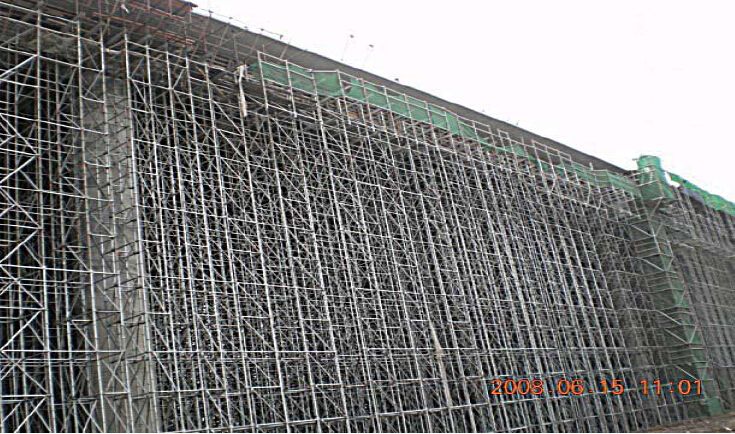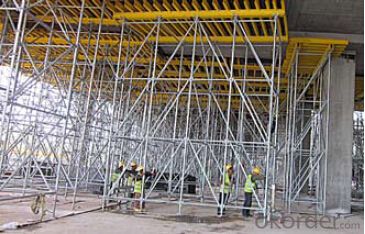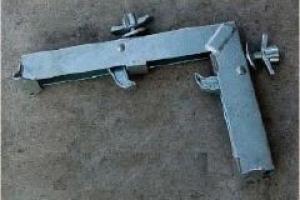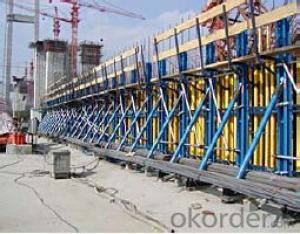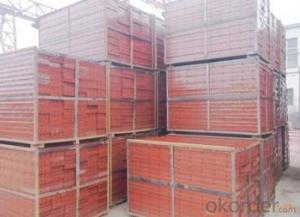Tower Scaffolding for Formwork and Scaffolding systems
- Loading Port:
- Tianjin
- Payment Terms:
- TT OR LC
- Min Order Qty:
- 50 m²
- Supply Capability:
- 1000 m²/month
OKorder Service Pledge
Quality Product, Order Online Tracking, Timely Delivery
OKorder Financial Service
Credit Rating, Credit Services, Credit Purchasing
You Might Also Like
Tower Scaffolding
Shoring tower is an effective supporting system. It is easy to assemble and dismantlement, and
has excellent stability and bearing capacity. It has been widely used in the construction of industry
& residential buildings , bridges, tunnels and dam project, etc.
Characteristics:
◆ High degree of standardization.
◆ Easy storage and transportation
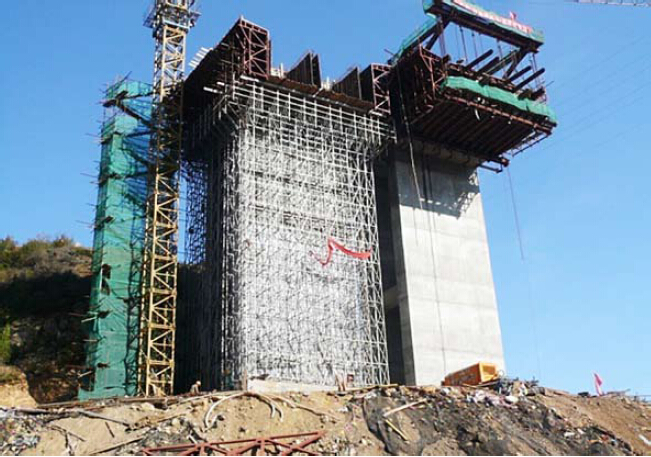
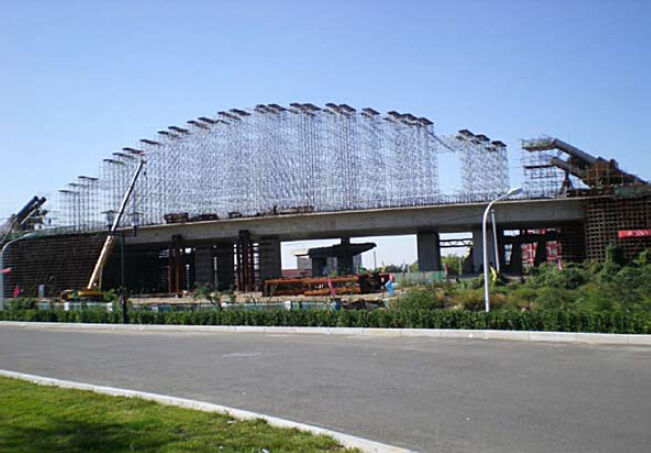
- Q: What are the common design considerations for steel formwork in marine environments?
- Some common design considerations for steel formwork in marine environments include corrosion resistance, durability, strength, and stability. Steel formwork used in marine environments should be made from corrosion-resistant materials, such as stainless steel or galvanized steel, to prevent degradation due to exposure to saltwater. It should also be designed to withstand harsh weather conditions, including high winds and waves, to ensure its longevity. Additionally, the formwork should have sufficient strength and stability to support the weight of concrete and withstand the forces exerted by the marine environment. Proper sealing and maintenance of the formwork are also vital to prevent water infiltration and maintain its effectiveness.
- Q: Can steel formwork be used in precast concrete applications?
- Precast concrete applications can indeed utilize steel formwork. Steel, being a versatile and durable material, can withstand the pressures and forces exerted throughout the precasting process. It offers exceptional support and stability during pouring and curing, aiding in the creation of precise shapes and detailed concrete elements. This results in accurate dimensions and a top-notch finish. Moreover, steel formwork can be swiftly assembled and disassembled, making it ideal for fast-paced and repetitive precast production. Overall, due to its strength, versatility, and ease of use, steel formwork is extensively employed in precast concrete applications.
- Q: How does steel formwork handle concrete consolidation and compaction?
- Steel formwork is highly suitable for concrete consolidation and compaction due to its durability and rigidity. The strong and rigid nature of steel formwork allows it to withstand the pressure exerted during concrete pouring and compaction. Additionally, steel formwork provides a smooth surface that facilitates proper consolidation and compaction of concrete, resulting in a high-quality finished product.
- Q: How does steel formwork contribute to the overall energy efficiency of the building?
- Steel formwork contributes to the overall energy efficiency of the building in several ways. Firstly, steel formwork is highly durable and long-lasting, meaning that it can be reused multiple times for different construction projects. This reduces the need for new formwork materials, which in turn reduces the energy and resources required for manufacturing and transportation. Additionally, steel formwork allows for more precise and accurate construction, leading to tighter and better-insulated structures. This improved insulation helps to minimize heat transfer and air leakage, resulting in reduced energy consumption for heating and cooling. By providing a solid and airtight barrier, steel formwork helps to create a more energy-efficient building envelope. Furthermore, steel formwork enables the construction of complex shapes and designs, allowing architects to incorporate energy-efficient features such as passive solar heating, natural ventilation, and daylighting strategies. These design elements can significantly reduce the reliance on artificial lighting, heating, and cooling systems, further enhancing the overall energy efficiency of the building. Lastly, steel formwork is often used in conjunction with other sustainable building materials, such as recycled steel or eco-friendly concrete mixtures. This combination of materials enhances the overall sustainability of the construction process and reduces the environmental impact associated with traditional formwork materials. In summary, steel formwork contributes to the overall energy efficiency of the building through its durability, precision construction, ability to support energy-efficient designs, and use of sustainable materials. By incorporating steel formwork into a construction project, builders can help create buildings that are more energy-efficient, reducing their environmental footprint and promoting sustainable development.
- Q: Can steel formwork be used for both symmetrical and asymmetrical concrete elements?
- Yes, steel formwork can be used for both symmetrical and asymmetrical concrete elements. Steel formwork is highly versatile and can be customized to meet the specific requirements of any concrete structure, regardless of its shape or complexity. It offers the advantage of being easily adjustable, allowing for the creation of both symmetrical and asymmetrical shapes. Additionally, steel formwork provides excellent strength and durability, ensuring that it can withstand the pressure exerted by the concrete during the pouring and curing process. This makes it a suitable choice for a wide range of concrete elements, including walls, columns, beams, slabs, and more.
- Q: How does steel formwork handle complex geometries?
- Steel formwork is able to handle complex geometries due to its inherent strength and flexibility. The steel panels can be easily cut and shaped to fit intricate designs, allowing for the creation of complex shapes and curves. Additionally, steel formwork can be assembled and disassembled, making it highly adaptable to different geometries and construction requirements. The rigidity and stability of steel also ensure that the formwork maintains its shape during concrete pouring, resulting in precise and accurate structures. Overall, steel formwork offers the versatility and durability needed to effectively handle complex geometries in construction projects.
- Q: What are the different types of bracing used with steel formwork?
- There are several types of bracing commonly used with steel formwork, including diagonal bracing, horizontal bracing, and vertical bracing. Diagonal bracing is used to provide stability and resistance against lateral forces, while horizontal bracing helps to control deflection and ensure the formwork remains in place. Vertical bracing is used to support the formwork system vertically and prevent any potential collapse. These different types of bracing work together to ensure the safety and stability of the steel formwork during construction.
- Q: How does steel formwork affect the overall fire resistance of a structure?
- The overall fire resistance of a structure is not directly affected by steel formwork, as its main purpose is temporary support during concrete pouring and construction. The fire resistance of a structure is generally determined by the construction materials, including the type of concrete, insulation, and fireproofing systems. However, steel formwork can indirectly contribute to the fire resistance by ensuring proper placement and compaction of the concrete, which is crucial for achieving the desired fire resistance rating. When mixed and compacted correctly, the strength and durability of the concrete can improve the overall fire resistance of the structure. Moreover, steel formwork can provide a smooth and uniform surface finish, which facilitates the application of fireproofing materials. Fireproofing coatings or sprays are often used to enhance the fire resistance of structural elements like beams and columns. The smooth surface offered by steel formwork helps ensure an even and effective application of these fireproofing materials, thus further improving the fire resistance of the structure. It is important to remember that although steel formwork itself is not fire resistant, it is usually removed once the concrete has cured. The final fire resistance of the structure is determined by the materials used in its permanent construction.
- Q: What are the characteristics of steel formwork
- The weight is light, the board width is big, the weight of the combined steel formwork can be reduced by 1/4~1/5, and the width of the template plate can be enlarged, and the joint of the template group is reduced.2, reduce the amount of steel, than the combination of steel templates can be reduced by 1/2.
- Q: How does steel formwork handle vibrations from construction equipment?
- Steel formwork is known for its excellent strength and durability, which enables it to effectively handle vibrations from construction equipment. The rigid nature of steel formwork allows it to withstand the impact and oscillations caused by heavy machinery or equipment without significant deformation or damage. Additionally, the structural stability and stiffness of steel formwork help to minimize any unwanted movement or shaking during construction activities, ensuring a stable and reliable foundation for the construction process.
Send your message to us
Tower Scaffolding for Formwork and Scaffolding systems
- Loading Port:
- Tianjin
- Payment Terms:
- TT OR LC
- Min Order Qty:
- 50 m²
- Supply Capability:
- 1000 m²/month
OKorder Service Pledge
Quality Product, Order Online Tracking, Timely Delivery
OKorder Financial Service
Credit Rating, Credit Services, Credit Purchasing
Similar products
Hot products
Hot Searches
Related keywords


